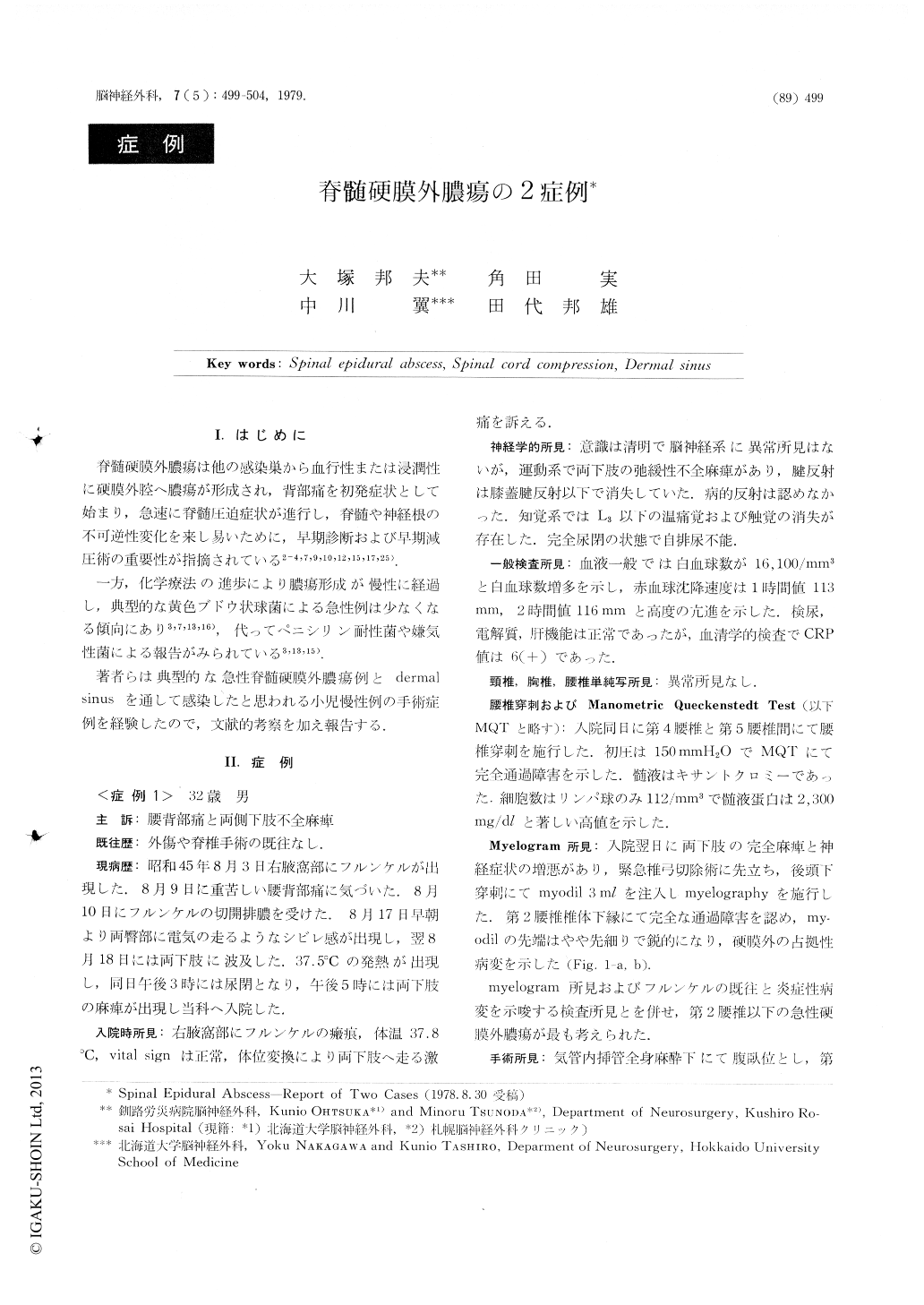Japanese
English
- 有料閲覧
- Abstract 文献概要
- 1ページ目 Look Inside
I.はじめに
脊髄硬膜外膿瘍は他の感染巣から血行性または浸潤性に硬膜外腔へ膿瘍が形成され,背部痛を初発症状として始まり,急速に脊髄圧迫症状が進行し,脊髄や神経根の不可逆性変化を来し易いために,早期診断および早期減圧術の重要性が指摘されている2-4,7,9,10,12,15,17,25).
一方,化学療法の進歩により膿瘍形成が慢性に経過し,典型的な黄色ブドウ状球菌による急性例は少なくなる傾向にあり3,7,13,16),代ってペニシリン耐性菌や嫌気性菌による報告がみられている3,13,15).
Spinal epidural abscess is a well known neurosurgical emergency characterized by acute onset of hack pain and paraparesis. Whereas, recent advances of chemotherapy and changing spectrum of bacteria have brought up the problem of chronic from of epidural abscess.
This report concerns two cases of spinal epidural abscess, one acute and the other chronic, which were successfully treated by surgical procedure and chemotherapy.
〔Case 1〕 A 32-year-old man was admitted on Aug. 18, 1970, because of low back pain and paralysis of both legs. He was in excellent health until two weeks before admission when he had a furuncle in the right axillary region. Nine days before admission he awoke with low back pain. On the morning of admission he experienced the sudden onset of numbness and paresthesia in both legs followed by dysuria and progressive paraparesis.
General physical examination on admission was not remarkable except for fever of 37.8℃. Neurological examination showed flaccid paresis of the legs with absent DTRs, and analgesia in the distribution of L3 - S3 bilaterally. Positive laboratory data included WBC of 16,100/mm3 and elevated ESR. A lumbar puncture revealed total block of spinal passage with xanthochromic spinal fluid, lymphocytes of 112/mm3 and a total protein of 2,300 mg/dl.
A myelogram via cisternal puncture showed complete block of contrast medium at the lower ridge of the second lumbar vertebra, indicating a mass in the epidural space ( Fig. 1-a and b).
The preoperative diagnosis of epidural abscess was made. On the second hospital day he was treated by emergency laminectomy of L1 to L4 with evacuations of epidural pus. Culture showed staphylococcus aureus, for which appropriate antibiotics were administered.
He recovered completely about 6 months postoperatively.
〔Case 2〕 A 3-year-old boy was admitted on Mar. 6,1976, because of difficulty in walking and passing urine. Three months before admission, he had an episode of high fever 〔39℃〕 of one week's duration. Two months before entry his parents noticed he had paralysed legs and dysuria. Two weeks before admission a pediatrician found epidural pus by lumbar puncture.
General physical examination revealed dermal sinus of about 1 mm diameter in the region of L5. Neurological examination showed paralysis of both legs with muscle atrophy, areflexia of both legs and analgesia in the distribution of S1 - S3. CBC disclosed no evidence of inflammations. Plain lumbar films showed spina bifida in the fifth lumbar and the first sacral verebrae and enlargement of interpedunclar distance at the fourth, fifth lumbar and the first sacral vertebrae (Fig. 2-a ). A myelogram via cisternal puncture showed complete block at the lower ridge at the third lumbar vertebra (Fig. 2-a and b).
Operative findings showed that the dermal sinus was connected to the epidural granulation, and the defect of laminae and spinal processes were confirmed in the fifth lumbar and the first sacral vertebrae. Laminectomy of L1 to L4 were performed, and thick granulation tissues covering posterior aspect of the epidural space, of L3 to S1, were removed (Fig. 3).
Postoperatively, the patient was treated with A-B penicillin, cephalothin and gentamycine. He became able to walk by himself without cane three weeks postoperatively, but it took about 2 years before he recovered completely without any neurological deficit.
Photomicrographic findings of the epidural tissues were characterized by connective tissue associated with chronic inflammatory cells and vascular proliferations (Fig. 4).

Copyright © 1979, Igaku-Shoin Ltd. All rights reserved.


